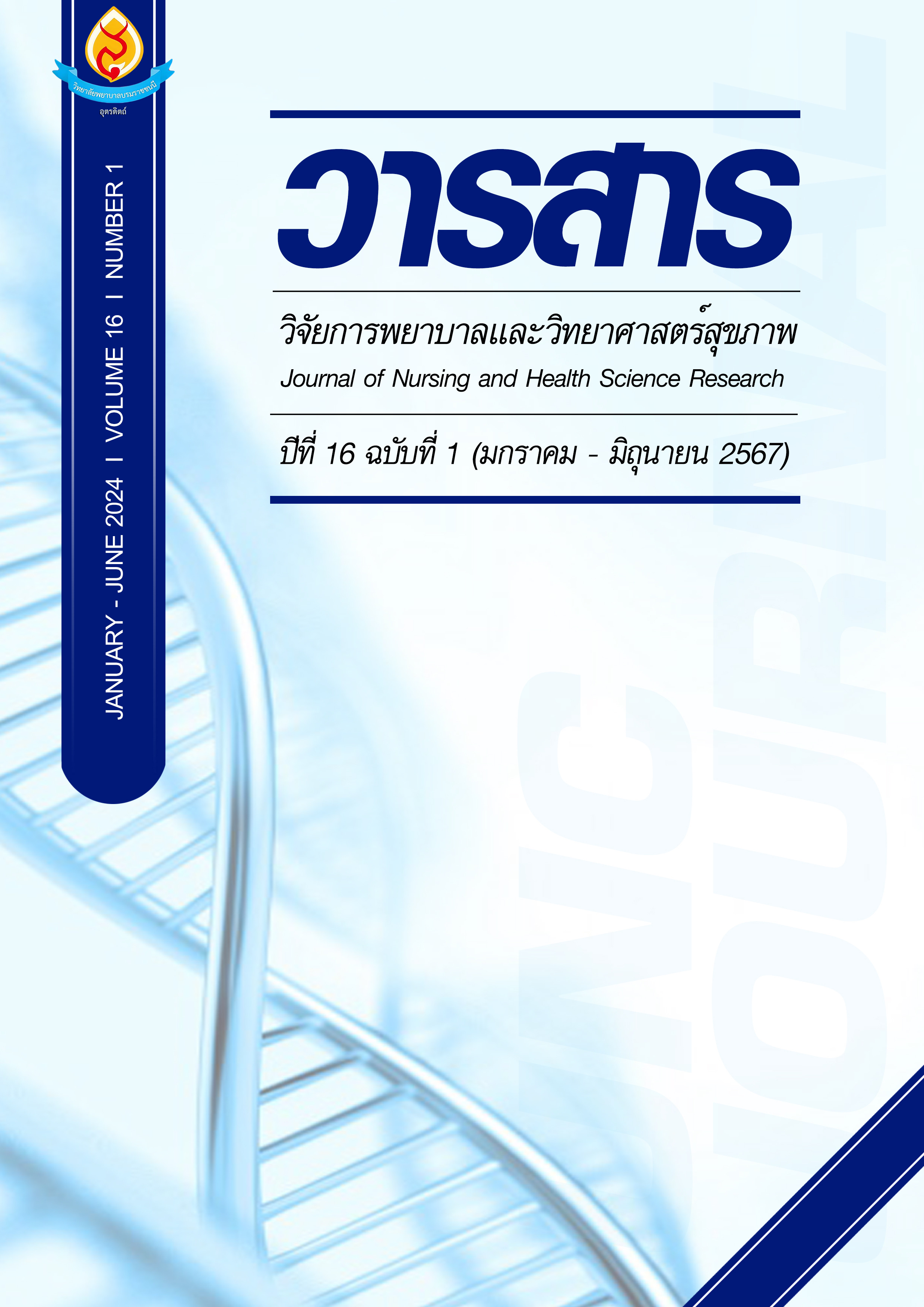การมีสุขภาวะแบบพฤฒพลังของผู้สูงอายุไทยในสังคมสูงวัย: การศึกษาสถานการณ์ในพื้นที่จังหวัดชัยนาทภายใต้บริบทพื้นที่เขตภาคกลางของประเทศไทย
Main Article Content
บทคัดย่อ
การวิจัยครั้งนี้มีวัตถุประสงค์เพื่อศึกษา 1) ระดับการมีสุขภาวะแบบพฤฒพลังของผู้สูงอายุ และ 2) เปรียบเทียบการมีสุขภาวะแบบพฤฒพลังของผู้สูงอายุในเขตจังหวัดชัยนาทจำแนกตามอายุ ความสามารถในการปฏิบัติกิจวัตรประจำวันขั้นพื้นฐาน และเขตพื้นที่อยู่อาศัย กลุ่มตัวอย่างเป็นผู้สูงอายุที่อาศัยอยู่ที่บ้านในเขตพื้นที่จังหวัดชัยนาท จำนวน 628 ราย ที่ถูกคัดเลือกโดยการสุ่มแบบหลายขั้นตอน (Multi-Stage Sampling) เครื่องมือที่ใช้ ได้แก่ 1) แบบรวบรวมข้อมูลส่วนบุคคล 2) แบบประเมินการสูงวัยอย่างมีศักยภาพ และ 3) การวัดระดับความสามารถในการทำกิจวัตรประจำวันขั้นพื้นฐาน การวิเคราะห์ข้อมูลใช้สถิติเชิงพรรณนา โดยใช้ค่าความถี่ ร้อยละ ค่าเฉลี่ย และส่วนเบี่ยงเบนมาตรฐาน สถิติอ้างอิงใช้การวิเคราะห์ความแปรปรวนทางเดียว (One way ANOVA/ F-test)
ผลการวิจัยพบว่าผู้สูงอายุในจังหวัดชัยนาทมีสุขภาวะแบบพฤฒพลังโดยรวมอยู่ในระดับปานกลาง ( = 69.39 ± SD 18.38) เมื่อพิจารณาการมีสุขภาวะแบบพฤฒพลังในองค์ประกอบรายด้าน ทั้งในด้านสุขภาพ อยู่ในระดับมาก ส่วนด้านการมีส่วนร่วมและด้านความมั่นคงปลอดภัยพบอยู่ในระดับปานกลาง (
= 36.58, 21.91, 10.90, SD = 9.10, 7.48, 3.99 ตามลำดับ) เมื่อเปรียบเทียบระดับการมีสุขภาวะแบบพฤฒพลังโดยรวมของผู้สูงอายุในจังหวัดชัยนาทจำแนกตามปัจจัยส่วนบุคคล ผลการเปรียบเทียบพบว่าระดับการมีสุขภาวะแบบพฤฒพลังโดยรวมของผู้สูงอายุมีความแตกต่างตามกลุ่มอายุ ความสามารถในการปฏิบัติกิจวัตรประจำวันขั้นพื้นฐาน (ติดสังคม ติดบ้าน ติดเตียง) และเขตพื้นที่อยู่อาศัย (เขตเมือง เขตกึ่งเมืองกึ่งชนบท และเขตชนบท) อย่างมีนัยสำคัญทางสถิติที่ระดับ .05 โดยผู้สูงอายุที่มีอายุน้อยมีความสามารถในการปฏิบัติกิจวัตรประจำวันขั้นพื้นฐานด้วยตนเองได้ กลุ่มติดสังคมและอาศัยอยู่ในเขตกึ่งเมืองกึ่งชนบท พบมีระดับการมีสุขภาวะแบบพฤฒพลังสูงกว่ากลุ่มอื่น
ผลที่ได้จากการศึกษาครั้งนี้จะช่วยนำไปใช้วางแผนกลยุทธ์ กำหนดนโยบายและเป็นแนวทางในการพัฒนาส่งเสริมการมีสุขภาวะแบบพฤฒพลังรายด้าน เพื่อยกระดับคุณภาพชีวิตของผู้สูงอายุในสังคมสูงวัยอย่างสมบูรณ์ที่สอดคล้องตามบริบทพื้นที่จังหวัดชัยนาทเพิ่มขึ้น
Article Details

อนุญาตภายใต้เงื่อนไข Creative Commons Attribution-NonCommercial-NoDerivatives 4.0 International License.
บทความหรือข้อคิดเห็นใดใดที่ปรากฏในวารสารวิจัยการพยาบาลและวิทยาศาสตร์สุขภาพ เป็นวรรณกรรมของผู้เขียน ซึ่งบรรณาธิการหรือสมาคมศิษย์เก่า ไม่จำเป็นต้องเห็นด้วย และบทความที่ได้รับการตีพิมพ์เผยแพร่ถือเป็นลิขสิทธิ์ของวารสารวิจัยการพยาบาลและวิทยาศาสตร์สุขภาพ
เอกสารอ้างอิง
Chainat Provincial Statistical Office. (2020). Chainat provincial statistical report: 2021. Chainat:
Nongluck print. Retrieved (2023, December 5). from https://province.nso.go.th/chainat/reports-publications/provincial-statisticsreport/spb2564.html. (in Thai).
Chananin, Y., Jullamate, P. & Piphatvanitcha, N. (2020). Active ageing among community dwelling older adults in Ubon Ratchathani province. Nursing Journal of the Ministry of Public Health, 30(2), 83-92. (in Thai).
Charoensrirungrueng, R. (2020). Factors associated with participation active aging among elderly people in Krokphra district, Nakhonsawan province. (master’s thesis). Naresuan University. (in Thai).
Development of Older Persons. (2024). Statistic of older persons 2022. Retrieved (2024, January 12).
from https://www.dop.go.th/th/statistics_page?cat=1&id=2. (in Thai).
Development of Older Persons. (2023). Situation of the Thai older persons 2022. Bangkok:
Amarin Corporations Public Company Limited. Retrieved from (2023, December 5). https://www.dop.go.th/th/statistics_page?cat=1&id=2. (in Thai).
Jitapunkul, S., Kamolratanakul, P. & Ebrahim, S. (1994). The meaning of activities of daily living in a Thai elderly population: development of a new index. Age and Ageing, 23(2), 97-101.
Jumniensuk, A., Nanthamongkolchai, S., Munsawaencsub, C. & Pitikultang, S. (2017). Life stability the elderly after retirement social support. Journal of Public Health, 45, 30- 42. (in Thai).
National Statistical Office, Digital Ministry for Economic and Society. (2017). Active ageing index of Thai elderly. Bangkok: Text and Journal Publication. (in Thai).
Saengprachaksakula, S. (2014). Active aging of Thai elderly. Journal of Social Sciences Srinakharinwirot University, 17, 231-248. (in Thai).
Saengprachaksakula, S. (2015). The determinants of Thai active ageing level. Songkhlanagarind, 21(1), 139-167. (in Thai).
Thanakwang, K., Isaramalai, S. & Hatthakit, U. (2014). Contextual potential aging Thai culture from the perspective of the elderly: a qualitative study. Pacific Rim International Journal of Nursing Research, 18(2), 152-165. (in Thai).
Thanakwang, K., Isaramalai, S. & Hatthakit, U. (2015). Development and psychometric testing of the active aging scale for Thai adults. (master’s thesis). Prince of Songkla University. (in Thai).
The Bureau of Registration Administration, Department of Provincial Administration. (2018).
Official statistics registration systems 2019. Retrieved (2023, December 5). from
https://stat.bora.dopa.go.th/stat/statnew/statMenu/newStat/home.php. (in Thai).
United Nation [UN]. (2017). World populations ageing 2017. New York: United Nations.
Wongkeenee, W., Chintanawa, R. & Sucamvang, K. (2013). Factors predicting active ageing among population of Mueang district, Chiang Mai province. Nursing Journal, 40(4), 91- 99. (in Thai).
World Health Organization: WHO. (2002). Active ageing: a policy framework. Geneva: World
Health Organization.


